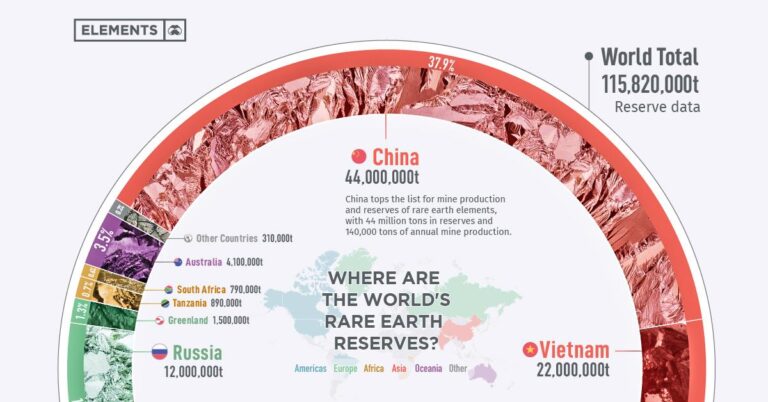Australia is making a bold push to challenge China’s long-standing dominance in the global rare earths market, a critical sector underpinning the production of high-tech devices and renewable energy technologies. With surging demand for these essential minerals, Canberra is accelerating efforts to develop its own supply chains and reduce reliance on Chinese exports. This strategic move aims to bolster national security and support global efforts to diversify sources of rare earth elements, positioning Australia as a key player in a market traditionally monopolised by China.
Australia’s Strategic Push to Challenge China’s Rare Earth Monopoly
In an effort to disrupt China’s overwhelming grip on the rare earth element supply chain, Australia is ramping up investments in mining and processing capabilities across its territory. This strategic move is fueled by growing global concerns over supply security, particularly as these critical minerals are essential for manufacturing electric vehicles, smartphones, and advanced defense systems. Australian authorities are not only focusing on expanding extraction but are also prioritizing sustainable and environmentally responsible methods to appeal to international partners wary of ecological damage.
To bolster its position, Australia is forging partnerships with key allies and developing infrastructure to enhance export capacity. Key initiatives include:
- Establishment of new processing plants capable of refining rare earths domestically
- Innovation grants aimed at reducing dependence on traditional Chinese technologies
- Strategic stockpiling to mitigate risks of supply chain disruptions
| Category | Australia’s Output (2023) | Global Share (%) |
|---|---|---|
| Rare Earth Mining | 12,000 tons | 8% |
| Processing Capacity | 5,000 tons | 4% |
| Export Volume | 9,000 tons | 6% |
Investing in Sustainable Mining and Processing Technologies
Australia is accelerating its commitment to embrace cutting-edge technologies that reduce the environmental footprint of rare earth extraction and processing. By investing in innovations such as hydrometallurgical techniques and bioleaching processes, the nation aims to minimize water usage, energy consumption, and toxic waste generation-offering a viable alternative to conventional mining methods that have long been criticized for their ecological damage. These sustainable solutions not only promise to lower operational costs but also align with global demands for green supply chains, positioning Australia as a responsible leader in the supply of critical materials.
Key initiatives include partnerships with research institutions and industry leaders to develop scalable processing plants equipped with modular technology, enabling rapid deployment and adaptability. Below is a breakdown of some innovative approaches currently under development:
- Electrochemical Separation: Enhanced purity with reduced chemical waste
- Renewable Energy Integration: Solar-powered processing units to cut carbon emissions
- Closed-Loop Water Systems: Recycling water to avoid contamination and resource depletion
| Technology | Environmental Benefit | Current Status |
|---|---|---|
| Hydrometallurgy | Lower pollutant discharge | Commercial pilot stage |
| Bioleaching | Non-toxic extraction | Research & development |
| Solar-powered Units | Zero carbon footprint | Early implementation |
Policy Recommendations to Strengthen Domestic Rare Earth Supply Chains
To reduce reliance on foreign sources, particularly China, Australia must prioritize investment in advanced mining technologies that improve the efficiency and environmental sustainability of rare earth extraction. Encouraging research partnerships between universities and the private sector can accelerate innovation in processing techniques, enabling a greater proportion of rare earth materials to be refined domestically. Additionally, implementing robust incentives, such as tax breaks and grants for companies committing to local supply chain development, will help establish a resilient rare earth ecosystem.
Strengthening regulatory frameworks to streamline permitting processes and ensure environmental safeguards without unnecessary delays is essential. Policymakers should foster collaborative platforms involving government agencies, industry leaders, and indigenous communities to create transparent supply chain practices. The following table outlines key areas for policy focus and their potential impact:
| Policy Focus | Action | Expected Impact |
|---|---|---|
| Innovation Funding | Boost R&D grants | Accelerate processing capabilities |
| Incentives | Tax credits for local sourcing | Increase domestic production |
| Regulatory Reform | Streamline approvals | Faster project initiation |
| Stakeholder Engagement | Collaborative platforms | Enhanced transparency & trust |
In Summary
As Australia accelerates its efforts to challenge China’s dominance in the rare earths market, the global race for critical minerals is entering a new phase. With strategic investments and partnerships underway, Canberra aims not only to bolster its own supply chains but also to reshape the geopolitical landscape of these indispensable resources. The success of Australia’s bid will have far-reaching implications for technology industries worldwide, signaling a potential shift in power over the minerals that underpin the future of clean energy and advanced electronics.




